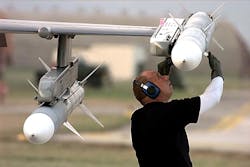Raytheon to redesign and recertify embedded computing components in ageing AMRAAM air-to-air missile
EGLIN AIR FORCE BASE, Fla. – Airborne weapons designers at Raytheon Technologies Corp. will redesign and recertify embedded computing components in one of the nation's most sophisticated radar-guided air-to-air missiles for the U.S. Air Force, Navy, and military allies under terms of a $17.9 million order announced last week.
Officials of the Air Force Life Cycle Manager Center at Eglin Air Force Base, Fla., are asking the Raytheon Missiles & Defense segment in Tucson, Ariz., to recertify a new synchronous dynamic random access memory (SDRAM) on the AMRAAM's central processor circuit card.
The air-to-air missile contract also asks Raytheon to make lifetime buys of known obsolete components to keep the missiles operational for the foreseeable future.
Although AMRAAM is one of the world's most advanced radar-guided air-to-air missiles, it's not a new system. It has been in service for three decades, first seeing deployment in 1991. Over the course of the missile's lifetime, some of its electronic components have gone obsolete, which makes them difficult to obtain for repairs and upgrades.
Raytheon will make lifetime buys of all known obsolete AMRAAM components from integrated circuit manufacturers and electronics distributors, and will stockpile them to accommodate future needs.
Moreover, Raytheon missile experts will redesign and recertify SDRAM chips in the AMRAAM central processor circuit card because current supplies of these components were insufficient to meet projected demand, or were considered too old for further use.
AMRAAM is an all-weather, all-environment medium range air-to-air missiles The system is an active radar-guided intercept missile with inherent electronic protection capabilities for air-to-air applications against massed penetration aircraft and is designed to replace the AIM-7 Sparrow air-to-air missile.
The latest version of the missile, the AIM-120D, has improved accuracy via Global Positioning System aided navigation, improved network compatibility, and enhanced aircrew survivability via a two-way data link capability.
Related: Raytheon redesigns AMRAAM to extend missile's lifetime
The AMRAAM missile has air-to-air and surface-launch versions. In the air-to-air role, the weapon's advanced active guidance section provides the aircrew find targets quickly in challenging environments, Raytheon officials say.
AMRAAM has scored combat victories in Iraq, Bosnia, and Kosovo, Raytheon says. It uses digital technology, micro-miniaturized solid-state electronics, and active radar guidance for air combat and air defense.
AMRAAM provides multi-shot capability, and can be launched day or night, in all weather conditions. Its autonomous guidance capability provides the pilot with launch-and-leave ability to provide fast engagement of follow-on targets or the option to fire first and then run from targets.
AMRAAM's capabilities include quick fly-out, immunity to countermeasures, and the ability to reject radar clutter to attack low-altitude targets. The missile has active radar guidance, multi-shot capability, and the ability to launch from aircraft or from surface-to-air missile sites.
Raytheon also is developing the AMRAAM Extended Range missile for ground-based air defense, AMRAAM-ER will enable intercepts at longer distances and higher altitudes.
Procured by 36 countries, the AMRAAM has been integrated onto the F-16, F-15, F/A-18, F-22, Typhoon, Gripen, Tornado, and Harrier combat jets. The AIM-120C5 and AIM-120C7 are being integrated onto the F-35 Joint Strike Fighter.
On this contract Raytheon will do the work in Tucson, Ariz., and should be finished by July 2022. For more information contact Raytheon Missile Systems online at www.rtx.com/our-company/our-businesses/rmd, or the Air Force Life Cycle Management Center at www.aflcmc.af.mil.

John Keller | Editor-in-Chief
John Keller is the Editor-in-Chief, Military & Aerospace Electronics Magazine--provides extensive coverage and analysis of enabling electronics and optoelectronic technologies in military, space and commercial aviation applications. John has been a member of the Military & Aerospace Electronics staff since 1989 and chief editor since 1995.

